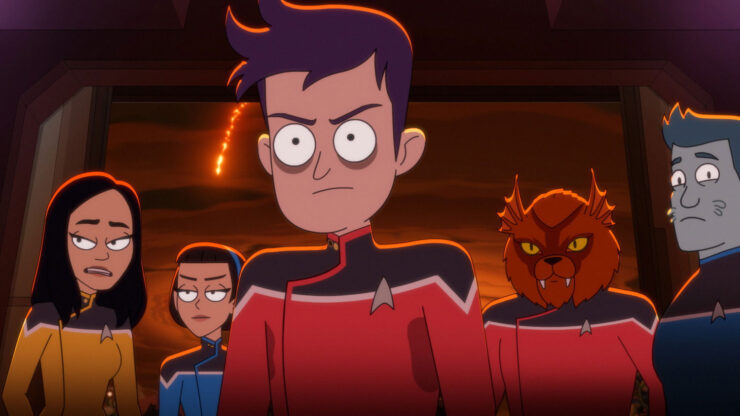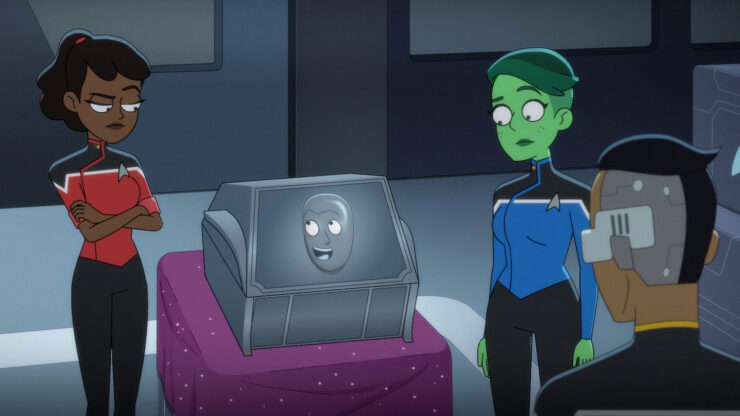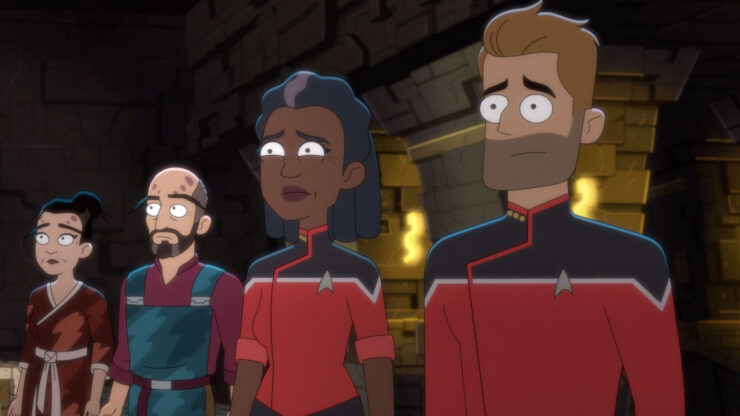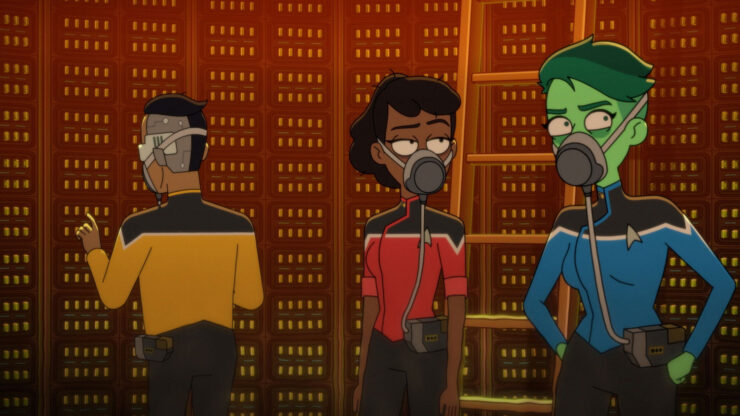One of the truisms of Star Trek is that oftentimes promotions aren’t as meaningful as they should be. There have been several occasions where someone was advanced (or, in one case, reduced) in rank and their responsibilities haven’t changed a lick. Spock went from a lieutenant commander to a commander on the original series. Sulu, Uhura, Scotty, and Chekov all got promoted throughout the movie series, yet kept winding up back at the same position they were in as lower ranks; ditto for the bridge crew of Discovery after jumping to the thirty-second century. Worf and Bashir got promoted from lieutenant junior-grade to lieutenant and La Forge, Dax, and Tuvok got promoted from lieutenant to lieutenant commander with no change in duties. Sisko went from commander to captain (though that was more of a course correction) but was still the same guy in charge. Paris went from lieutenant to ensign and back to lieutenant with absolutely no change.
This week’s Lower Decks shines a light on that to some degree.
The Cerritos is assigned to a giant ring with a biosphere on it that was built by a long-gone civilization and abandoned. It’s surrounding a sun, and it was colonized by the Corazonians. It’s run by an ancient computer called Vexilon. Everyone goes out of their way to make it clear that Vexilon is not, repeat not, that old Trek standby of an evil world-running computer that dominates the society. Vexilon is a pleasant world-running computer, eager to please, and perhaps a tad neurotic, though the latter is primarily due to it not functioning right.
Which is half of why the Cerritos is there: to try to figure out what’s wrong. It’s nothing major thus far, just some weather anomalies. Freeman, who minored in archaic computer systems at the Academy, tackles that.
Boimler, meanwhile, gets to do one thing that absolutely is a consequence of being promoted, but one rarely seen on Trek due to the people in the opening credits tending to do all the work: being put in charge of teams. (Though TNG did a nice job with this particular learning experience in “Pen Pals.”) He leads a team that also includes T’Lyn, Merp, Taylor, and Meredith. And, because Boimler is the king of self-sabotage, he screws it up. He insists on doing everything himself, leaving the others to sit around with their thumbs in their ears.
T’Lyn assumes it’s because he wants to keep the team safe—the job they’re doing is dismantling an outdated power station by carefully removing its explosively volatile parts, a job made more complicated by Vexilon’s malfunctions. But it’s more fundamental than that: Boimler was just an ensign last week. Now he’s ordering around people who were his peers a few days ago and he doesn’t feel worthy.

After T’Lyn gives him a kick in the ass, he finally lets Taylor, Meredith, and Merp help out.
Which is good, as Corazonia is falling to pieces. This part of the plot will be very familiar to anyone who owns a computer (which is probably all of you). Vexilon hasn’t installed an update in millennia. The Corazonians—who are artists and philosophers, mostly—have no idea how to do maintenance on Vexilon.
And, as anyone who’s installed a Windows update that made everything worse has experienced, Freeman’s attempt to install the latest update goes horribly horribly wrong. Eventually she’s able to figure out a way to get it restarted properly without it reverting to factory specs—which would include getting rid of the entire biosphere. However, it requires that they transfer Vexilon to the very power station that Boimler is dismantling and, indeed, had almost finished dismantling. Oops.
Buy the Book


System Collapse
They get it back together, and Freeman is able to save the day, with Boimler learning a valuable lesson.
The B-plot back on the Cerritos is a bit more of an issue for me. Don’t get me wrong, it’s very cleverly written, and a sitcommy plot that actually works (not always the case on this show). But it pulls a fast one at the end that is nicely done, but which ends up in a place I’m not happy about.
Okay, so this is where the lack of consequences to promotion gets play. Lieutenant Dirk assigns them to find the one isolinear chip out of millions that is malfunctioning. It’s another mindless, repetitive task that is just like what they did as ensigns.
And here’s where it starts to get interesting. Tendi starts to wonder if this is a hazing, a notion Mariner latches onto. Rutherford, bless his pointy little head, doesn’t even know what hazing is, which actually makes sense. It’s a pretty nasty practice, and as someone who spent a decent chunk of his early adolescent as a target for assholes (being a nerd wasn’t actually cool in the 1980s), I like the idea of a future where the practice has gone out of favor.
But Mariner and Tendi talk Rutherford into the notion that this mindless, repetitive, endless task (which includes occasionally being in a room filled with nitrogen coolant) is a hazing by the lieutenant of the newly promoted folks. And so they contrive a practical joke right back at Dirk by setting up a Wadi Chula game (the same one Sisko, Kira, Dax, and Bashir got stuck in in DS9’s “Move Along Home”) in his quarters, setting it up in a way that will get him stuck in it with a malfunctioning Betazoid greeting box (like the one seen in TNG’s “Haven”).

Only after that does Dirk reveal (a) how important the task is and (b) why he fobbed it off on four junior-grade lieutenants. He was stuck in a Chula game when he was a child and couldn’t get out for a month. Mariner distracts Dirk by letting him go on (and on) about Tellarite slop jazz while Tendi goes to finish checking the chips and Rutherford dismantles the prank.
The latter is especially hilarious because Rutherford accidentally trips the prank and has to go through the entire Chula game. But because Rutherford is awesome, he zips through in no time flat.
And then the cherry on top of all this? In the bar, our heroes are toasting their success and lamenting their silly notion that Starfleet officers would do this kind of hazing. Then we cut to across the room where Dirk and Ransom are toasting their successful hazing of the lieutenants, the entire Chula game story being bullshit on Dirk’s part to mess with the lieutenants’ heads.
Sigh. I mean, it’s a clever double-reverse, and it works as a piece of writing and as comedy. But it doesn’t work as Star Trek. And honestly, the story was still funny and clever without that final reveal.
It’s especially frustrating because they’ve done such a good job with making Ransom a more interesting character. There’s a hilarious bit early in the episode when the Corazonians are explaining how traumatic the malfunctions are to Freeman and Ransom, by pointing out that her sculptures have been poor. Ransom agrees, criticizing the form, only to be told that no, those are the good ones, the ones over here (which look exactly the same) are the poor ones. Ransom sighs and says they’re still pretty amateurish. It’s delightful.
And then in the end, he and Dirk are doing the twenty-first-century office dudebro thing congratulating each other on their hazing of the junior-grade lieutenants, and it just makes my teeth hurt. Maybe I’m just a humorless nerd, but I just thought that spoiled the whole thing.
Others will probably disagree, though. That’s the joy of the subjectivity of humor. And it wasn’t enough to ruin the whole episode, especially since the sitcom contrivances of reversing the prank before Dirk found out was actually funny. (I also now really want to hear some Tellarite slop jazz….) And it was also a really good episode for Boimler’s development, with bonus deadpan brilliance from T’Lyn. (“Ah. It is a volcano.”)

Random thoughts
- Trek has been full of world-running artificial intelligences that are evil and horrible, most of them on the original series: “Return of the Archons,” “The Apple,” “I, Mudd.” We also saw one on LD, AGIMUS, in “Where Pleasant Fountains Lie.”
- Your humble reviewer actually did a more serious treatment of this same notion twenty-three years ago: a world-running computer malfunctioning, but said computer was benevolent and its being dismantled was a bad thing. It was the Starfleet Corps of Engineers novella Fatal Error, and in that case the computer, Ganitriul, was sabotaged by terrorists.
- Taylor is a Kzinti. It’s yet another alien given a generic American white-person name. It was cute the first time, but it’s grown tiresome and lazy. At the very least, we should see it in reverse at some point—give a human an obviously Klingon or Vulcan or Andorian name or something…
- One of the perks of not being ensigns anymore is that our heroes are allowed in Anomaly Storage. Besides the Chula game and the greeting box, we also see a robot that looks a lot like Nomad from the original series’ “The Changeling,” and two weapons: a Vulcan lirpa (from the original series’ “Amok Time”) and a bat’leth (introduced in TNG’s “Reunion” and seen billions of times since).
- Billups has a ferret named Lancelot. It escapes, and keeps turning up in various parts of the ship. This doesn’t really go anywhere, but I just love that Billups has a ferret…
This piece was written during the 2023 WGA and SAG-AFTRA strikes. Without the labor of the writers and actors currently on strike, the series being covered here wouldn’t exist.
Keith R.A. DeCandido has a story in the newly released eighth issue of Star Trek Explorer magazine, “The Kellidian Kidnapping,” a Voyager tale that dramatizes an adventure alluded to in the series finale “Endgame.” There’s also a DS9 story by David Mack, “Lost and Founder.” You can find it at bookstores and comic shops, or order directly from Titan.










